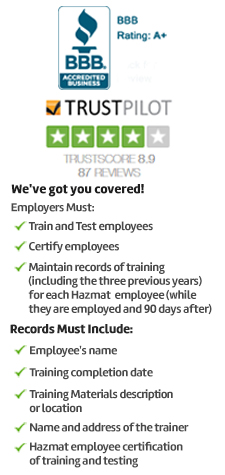
OSHA Office Ergonomics Training Course

This online Office Ergonomics Course trains candidates to gain knowledge on general ergonomics, symptoms and causes of health problems such as musculoskeletal disorder, understanding the link between the usage of smart phones and work postures with ergonomic health concerns, applicable safety regulations promoted by OSHA, employers’ and workers’ duties to maintain ergonomic safety and best work practices to make offices safer and healthier.
Governing regulations
OSHA Ergonomics safety guidelines provide helpful information to workers and employers to follow safe work methods to minimize injuries.
If, as an employer, you think there are no specific safety guidelines for your industry, you still have regulatory obligation under the General Duty Clause, Section 5(a)(1) which intends to keep workplaces free from hazards, that include risks caused by ergonomics. If you fail to comply with workplace safety regulations, OSHA can intimate you about the existence of ergonomic hazards under the General Duty Clause or communicate you through letters, as part of its enforcement program.
Course Overview
This online safety course provides glimpses on safe ergonomic practices for office workers to remain healthy. The participants will get to know unsafe work culture that can cause serious long-term health problems and smart ways to work to reduce injury or musculoskeletal disorders. The syllabus also covers causes for the most common injuries, solutions offered by science of ergonomics, informative case studies to explain the advantages of ergonomics, training procedures, applicable regulations and additional resources to gain more knowledge and management skills.
Who Must Take this Course?
Knowledge about ergonomics is applicable for workers belong to all industries. However, the types of ergonomics injuries and health issues vary depending upon the nature of work. Many would say people working in office are safe and don’t fall victim to occupational hazards compared to workers in industrial environments. However, long working in front of computers and sitting for hours in ergonomically unsafe posture can cause certain long-term health disorders, which can even lead to pre-mature death. It is imperative to adjust desks, tables, shelves and workstations properly to reduce the stress on workers, avoid unsafe posture while typing on a keyboard, watching computer monitor, holding the mouse, or talking over the telephone. If not taken care of, these unsafe ergonomic postures and practices can affect workers’ hands, neck, eyes, fingers, back, wrists, arms, and legs.
So, basically, every employee from the office environment must undergo this safety training before he or she resumes work responsibilities. Also, employers must ensure that even experienced workers should get regular training to understand new challenges, regulations and practices so that congenial work environment can be maintained. Workers whose occupation involves repetitive or stressful movement of certain body parts are more likely to get ergonomics health disorders which can affect specific body parts which are used frequently. Workers across all industries must join this course and gain knowledge on workplace health and safety.
Course Format
Our OSHA Office Ergonomics Training course provides candidates quality content, graphics and audio explanations and practice questions to clear the final exam.
Each student upon successful completion will get a Hard copy of completion certificate and also a printable wallet card.
Continuing education credits?
Each candidate can gain 0.2 CEUs (or 2 CMEs) once they successfully complete the course.
Topics Covered
- About This Course
- Section 1-Course Objectives
- Section 2-Introduction to Office Ergonomics Training
- Section 3-Why Do We Need Ergonomics Training?
- Section 4-Basic Concepts of Ergonomics
- Section 5-Ergonomic Hazards for Office Workers
- Musculoskeletal Disorders (MSDs)
- Carpal Tunnel Syndrome
- Symptoms of Carpal Tunnel Syndrome
- Rotator Cuff Syndrome
- Other MSDs of the Shoulders and Arms
- “Texting Thumb” and “iPad® Neck”
- Stages of MSDs
- Symptoms of MSDs
- Eyestrain-a Repetitive Stress Injury
- Back Pain
- Static Posture Problems
- Section 6-Ergonomics Can Make Your Workplace Better
- Ergonomics Can Improve Employee Well-Being
- Ergonomics Can Increase Productivity
- Ergonomics Can Lower the Cost of Injury Claims
- Section 7-Safety Standards
- OSHA
- CDC–NIOSH
- ANSI
- Section 8-Safety Responsibilities
- Safety Responsibilities of Employers
- Safety Responsibilities of Employees
- Section 9-Ergonomic Solutions
- Workstation Adjustments-Chair Height
- Workstation Adjustments-Chair Backrest
- Workstation Adjustments-Chair Armrest
- Workstation Adjustments-Monitor
- Workstation Adjustments-Keyboard and Mouse
- Workstation Adjustments-Work Copy and Reference Materials
- Workstation Adjustments-Telephone
- Workstation Adjustments-Surrounding Work Area
- Using Laptop Computers
- Alternative Workstation Arrangements-Dual Monitors
- Alternative Workstation Arrangements-Standing Desks
- Alternative Workstation Arrangements-Alternative Keyboards
- Alternative Workstation Arrangements-Unconventional Chairs
- New Considerations in the Workplace: Tablets and Cell Phones
- Work Environment Self-Assessment
- Administrative Improvements
- Section 10-Summary
- Section 11-Additional Resources

 NEBOSH CERTIFICATE
NEBOSH CERTIFICATE NEBOSH DIPLOMA
NEBOSH DIPLOMA IOSH
IOSH SAFETY DIPLOMA
SAFETY DIPLOMA CPD UK
CPD UK ROSPA UK
ROSPA UK FOOD SAFETY
FOOD SAFETY 



